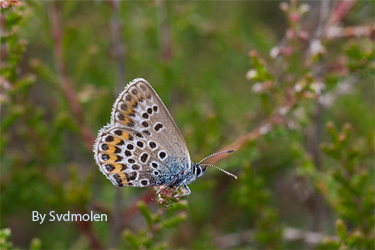Animal movement often changes with habitat quality. Butterfly movements may be influenced by structural attributes of habitat patches or may reflect the distribution of food, mates, host plants or ecological interactions. The relative influence of structural and functional factors on flight patterns is poorly understood, partly because butterfly movements are often described by simplified representations of actual trajectories. Using high-resolution GPS tracking accurate trajectories of routine movements of Plebejus argus were obtained in a heterogeneous natural landscape. Habitat quality in patches was ranked according to the abundance of host and nectar plants as well as the abundance of nests of its mutualistic ant Lasius niger. Movements were slow and winding in high quality habitats whereas faster, straighter flights were observed in poor habitats. At edges, butterflies often crossed without any exploratory behaviour towards patches of better quality, suggesting they may use cues to detect resources at some distance. Conversely, individuals usually stayed in the patch after exploring edges with other patches of lower quality. However, scanning also preceded exits towards clearly unsuitable habitat, compatible with transfers to distant high-quality patches. Authors conclude that patterns of movement in P. argus were explained by spatial heterogeneity defined by functional rather than structural criteria. It is also show that inexpensive handheld GPS receivers allow depicting detailed flying trajectories in open flat terrain revealing complex behavioural patterns. informacion[at]ebd.csic.es: Fernández et al (2016) Fine scale movements of the butterfly Plebejus argus in a heterogeneous natural landscape as revealed by GPS tracking. J Insect Behav 29:80–98 DOI 10.1007/s10905-016-9543-7
http://link.springer.com/article/10.1007/s10905-016-9543-7

 Las altas temperaturas están provocando que las lagunas y las marismas de Doñana pierdan agua rápidamente
Las altas temperaturas están provocando que las lagunas y las marismas de Doñana pierdan agua rápidamente




